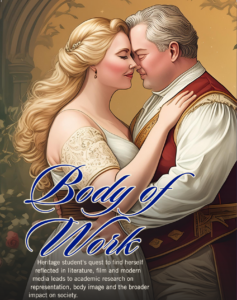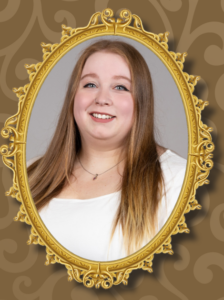Body of Work – Wings Summer 2024

English major Millie Land loves a good romance. Stories with strong women, smart women living wonderfully rich lives. Stories of women finding love, adventure and happiness. They are the women whose wit and spirit carry them through adversity with grace and whose beauty turns heads whenever they walk into a room. In books, their appearance is described in detail— raven-haired or with golden locks, tall or petite, skin the color of caramel, ebony or alabaster. Their figures may be slender, athletic or curvy, but one thing they never, ever are is fat.

Millie Land
“In our modern-day Western society we hold a very narrow standard of beauty when it comes to body composition. Thinness is revered, sometimes to the point where unhealthy bodies are held up as the standard we all must strive to achieve,” said Land. “Fatphobia in media, literature and social media is prevalent, and this portrayal diminishes individuals whose bodies do not conform to these impossible standards.”
What started as a study for Land to take on during her first research experience through the Leadership Alliance at Johns Hopkins has turned into a passion project. She’s spent the past four years returning to her analysis, often called to it without the pull of a class assignment. Land was so drawn to her research that by the time she enrolled in the course where she would compile her senior thesis, she had already completed enough analysis to move right into her writing.
THE MAKING OF AN ACADEMIC
Land wasn’t a traditional college student when she came to Heritage. She graduated from Selah High School in 2014 and wanted to be a veterinary technician. She started in a vet tech program at a community college and worked at a veterinary clinic when a puppy’s tragedy during a routine procedure showed her the dark side of caring for animals.
“I knew it wasn’t for me,” she said. “I couldn’t stand the heartbreak.”
Land left the program and her job. For the next six years, she worked as a home health aid and tried to figure out what she wanted to do for the rest of her life.
“I knew I wanted to do something that I really loved. That I was passionate about,” said Land. “I’ve always loved reading and writing and decided I would find a way to make a career out of that.”
Land enrolled at Heritage and declared her major in English. At the time, she thought she would get a degree and a job in something like copywriting, marketing, or teaching, although she wasn’t sure that the K-12 setting was right for her. Then, she took an ethnic literature class and met Dr. Winona Wynn, the director of the Mellon Mays and Leadership Alliance programs.
“Dr. Wynn started talking to me about the programs and the opportunities I had after Heritage. She introduced me to the idea of getting my Ph.D. and becoming a college professor,” she said. “She made it all seem so obtainable.”
That summer, Land became a Leadership Alliance Fellow. She found herself at Johns Hopkins in Baltimore, Maryland. The experience required her to pick a research topic for that summer’s focus.
“I knew I wanted to do some kind of analysis on body diversity and representation in the media,” said Land. “It is something that is very personal to me. I’ve struggled with my weight my entire life and never saw anyone in the books I read or the programs that I watched that I could relate to.”
THE BRIDGERTON EFFECT
At the time of Land’s summer research experience, the historical romance series Bridgerton, based on a book series by Julia Quinn, was one of the most-watched programs on Netflix. Millions of people binge-watched the program, wondering with great anticipation who the mysterious Lady Whistledown could be. Among the cast of glamorous characters was Penelope.
“Penelope was the only character who was like me. She was plus-sized and was dismissed by all the others. They only saw her as the poor soul destined to live life as a spinster. Nobody saw her cunningness or expected that she was amassing this empire for herself.
“I decided my study would focus on this series, mostly through critical analysis of the books.” It was a decision that would shape the trajectory of her academic career.
When Land returned from her ten weeks in Baltimore, she was changed. Her experience had shined a light on what she always felt was a truth in literature and the media, but now she was armed with the skills to bring that truth to light with academic analysis and evidence.
“People have always been fascinated by the human body. But our modern-day vision is much different than what was historically revered. Before the 19th Century, depictions of beauty in the human form, particularly that of women, were once much more aligned with what most women look like. They were more voluptuous and rounder, with soft bellies, protruding breasts and full thighs. Thinness has only been the beauty standard since the mid-1800s.
“Today, when a fat woman is represented in literature, movies, television, and social media, she is often portrayed as lazy and unworthy of love or appreciation. She is the fat, funny friend or the villain. Or, if she is a central character, her story is about losing weight. She can find love and happiness only after she gets the weight off.”
The effects of this lack of representation are chilling, she said, particularly when considering youth and young adult literature.
“If children only see fat people represented in a negative light, or valued only when they lose weight, their perception of people with larger bodies is skewed. They are taught that fat people are unworthy of success or love and must accept the way society treats them until they fit the standard beauty model. Moreover, it gives those who are not fat permission to belittle and bully those who are and damages the mental health of larger youth who are told again and again that they are unworthy and invisible.”
THE CONTROVERSY OF SIZE
The study of the portrayal of plus-size characters in literature and popular media is a surprisingly controversial research area. Some point to an obesity epidemic in America and the adverse health effects of being overweight as a reason why fat people should be excluded from the media. Others scoff at the idea of the study of weight stigma being a legitimate academic pursuit. However, Land points out that the pitfalls of turning a blind eye to the issue are substantial.
“The lack of body diversity representation in our media is taking its toll on our youth. It can contribute to the psychological development of eating disorders and takes a toll on mental health.
We are seeing children as young as eight years old dieting because they think they are too fat.
“The pushback that comes when a fat person is in the public light is ridiculous. Including fat people in our narratives isn’t glorifying obesity. It is including a significant percentage of our world’s population and inviting us all to the table to share the full range of human experiences.”
The good news is that there has been some positive movement in recent years to build inclusivity around body size in the media. Larger artists like Lizzo top the Billboards. Shows like This is Us have plus-size characters in leading roles that don’t focus on their weight loss journey. Even Bridgerton, the series that started Land’s research, is bringing its fat character into a leading romantic role. Still, there is a lot more work to be done.
“Fat people are here. We have careers and families. We live rich and rewarding lives. We experience success and failure, love and heartbreak. Our stories are not diminished because of our body size,” said Lund. “The media has the power to change societal standards by addressing representation in all forms. I hope that as we become a more inclusive society, we see more writers and creators expanding their ideas of diversity to include people of size. Only then will we start to see some real positive change.”
This spring, Land’s research while at Heritage came to a head. She submitted her senior thesis. “I got an A!” she said.
She is now working with her professors to fine- tune her thesis so that it will be used as part of her graduate school submissions. She is planning on applying for Ph.D. programs this fall. Additionally, she is looking at several options for publishing her work in scholarly journals.
“I see my research progressing in so many ways once I move on to graduate. I can focus just on literature, or I can focus on popular culture, media studies, cultural studies, art, and even activism,” she said. “That’s the beautiful thing about English studies; it is multifaceted. It allows us to see the world through others’ eyes and experiences through diverse perspectives. I am aiming to progress the conversation and write about the past and present to bring to light those different experiences and bring a voice to those who are underrepresented, such as those in fat bodies.”![]()
